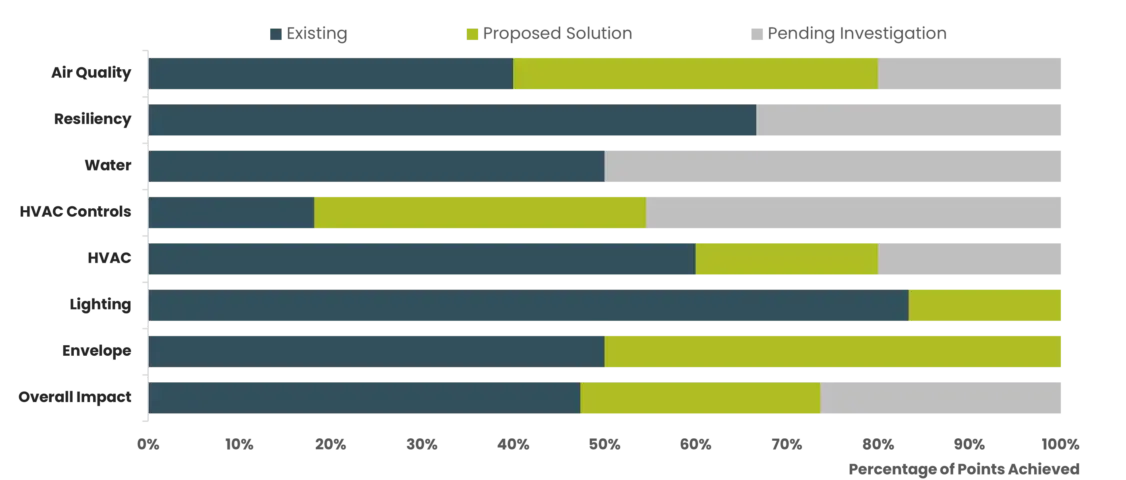Overview
LOCATION: Noida, India
SIZE: 38,574 m2
ASSET TYPE: Mixed-use office
BUILT: 2009
SUMMARY: The owner of a state-of-the-art, mixed-use office property engaged GreenGen to assess and prioritize capital improvements to enhance efficiency, reduce emissions, and position the property as a leader in the fast-growing India market.

Challenge
India’s rapid economic growth and urbanization have significantly increased energy demand, making the country the third-largest emitter globally, behind China and the United States. Yet, India’s per capita emissions remain notably low. The client saw an opportunity to integrate sustainable practices, steering away from carbon-intensive models of the past while positioning the property as a standout asset amid the nation’s booming development.
Although formal regulations for existing real estate are not yet in place, India’s commitment to achieving net-zero emissions by 2070 signals future policy developments. In anticipation, the client aimed to assess the evolving regulatory landscape and evaluate how the asset measures up against its peers.
The client sought a comprehensive evaluation of the asset to uncover inefficiencies, address underperforming systems, and further differentiate the property by improving energy performance, increasing tenant occupancy, and aligning with long-term sustainability goals. They engaged GreenGen to develop a strategic roadmap for improvements that would deliver ROI and enhance tenant demand, leveraging GreenGen’s expertise in integrating energy, real estate,
capital markets, and technology.
Assessment
GreenGen conducted a detailed energy, climate, and regulatory assessment in August 2024 to uncover inefficiencies and identify opportunities for improvement. The assessment revealed significant opportunities, particularly in reducing the building’s reliance on carbon-intensive energy sources and improving underperforming systems such as the chiller plant.
The property achieved 18 out of 39 points on GreenGen’s Best Practices Scorecard, demonstrating the need for strategic upgrades.
Best Practices Scorecard:

Key Findings:

Solutions
GreenGen recommended solutions in a phased approach taking into consideration the client’s goals, hold period, equipment performance and remaining useful life. Phase 1 included short term, high priority measures that are relatively simple to implement, cost-effective with short payback periods and deliver significant carbon reductions. Phase 2 included measures that require significant capital expenditure, have equipment with extended remaining useful life, or are not currently financially feasible, but should be planned for future implementation.
Phase 1 Measures:
Energy Efficiency Enhancements
• Install occupancy sensors on lighting in stairwells.
• Implement temperature/pressure reset strategies on HVAC.
• Add variable frequency drives on condenser water pumps.
• Insulate exposed chilled water loop and improve air filtration.
Onsite Renewable Energy
• Install ~100 kW rooftop solar PV to generate ~4% of electricity baseline.
Phase 2 Measures:
Chiller plant redesign
• GreenGen recommended a complete redesign of the chiller plant to address existing inefficiencies. The redesign would reduce the energy consumption of the chiller plant by ~20%, however, because all of the chillers are currently within the projected lifespan, this project is proposed as a future CapEx project as systems approach their end of useful life.
Results
The solutions proposed by GreenGen are expected to reduce energy consumption by ~9% and carbon emissions by ~14% by 2030, positioning the asset to achieve the highest 5-star rating in its category per India’s Bureau of Energy Efficiency (BEE). Short-term measures, including efficiency upgrades and renewable energy integration, are projected to deliver a 5% reduction in energy use and a 10% decrease in carbon emissions with a payback period of 6.8 years.
Even with the implementation of the recommended solutions and expected grid decarbonization targets the property will stay CRREM carbon non-compliant through 2050. However, it’s important to note that CRREM regularly updates its models for energy and carbon compliance. While there is not a direct path to energy compliance today, this is subject to change as CRREM models are updated to better account for India’s market.
The overall strategy enhances tenant appeal and increases the property’s market value by an estimated ₹ 39,710,000. The client is currently pursuing CapEx approval for the proposed measures, setting the stage for significant long-term operational and environmental benefits.
Phase 1 Estimated Results:

Interested in working with the GreenGen team? Reach out to us!
